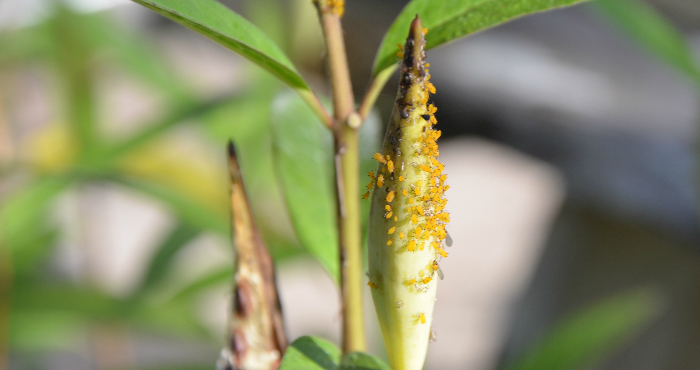July 18, 2019
Horror movies have, for over a century, featured a pantheon of destructive creatures rampaging through the world. Their characteristic have varied over the decades, but they always manage to return.
In recent years zombies have been the nightmare of choice. Kill one and 5000 come to its funeral, and then return to sacking society.
More than half a century ago it was vampires. Bella Lugosi terrified audiences as Count Dracula, the Transylvanian predator whose sole desire was to suck the life out of victims.

Aphids insatiable thirst
It is hard to fathom such real life fiends lurking in the dim recesses of a theater, much less Wakulla County’s landscape, but they do. As hideous as the thought may be, the area is now literally crawling with these life draining creatures.
Aphids, fortunately for the human residents and animal occupants, have an insatiable thirst for the juices of plants. They easily locate a suitable stationary victim and latch on to satisfy their unquenchable need.
Aphids avoid the sun
Much like the celluloid villain with a black cape, aphids avoid the exposure to the sun.
Instead they prefer to stay in the shady cloisters of their plant hosts. All the while these tiny parasites are slowly draining the life sustaining fluids by using their piercing mouthparts to savage the plant’s vascular system.
Aphids are minute pear-shaped, soft-bodied insects. Their potential for plentiful reproduction and ability to transmit viral diseases make aphids a significant pest of crops worldwide.
Several variations of the aphid’s life cycle
There are approximately 4,400 aphid species worldwide in the Aphididae family, but are more commonly found in the warmer regions of the globe. There are several variations of the aphid’s life cycle which depends on several environmental factors.
In Wakulla County’s spring, female nymphs hatch from the eggs on the primary host plant and feed to maturity. Aphids alternate primary host plants with secondary hosts.
Winged forms of this insect migrate and feed on summer crops available at the time. Winds will carry the tiny aphids to locales far beyond their ability to fly unaided.
Hatching in the fall
Males and females are hatched in the fall. They then migrate onto winter hosts where eggs are laid for overwintering during the cold weather.
Depending on the specie, aphids come in several colors locally. Red, black, yellow and green are found in north Florida.
A wooden stake through an aphid’s heart would be challenging at best, but even they have a vulnerability to forces far beyond their control. The worst nightmare of this plant parasite arrives on brightly colored armor plated wings.
Ladybugs have a taste for aphids
Ladybugs or lady beetles are tiny carnivores with an affinity for eating aphids as the former blithely dine on the plants. Slow and soft bodied, the aphids are easy prey for the much larger ladybugs’ fearsome jaws.
Close examination reveal the ladybug’s mandibles would be the envy of any avenging hero sent to right the wrongs perpetrated on hapless victims. Aphids stand no chance of survival when encountering a ladybug.
Of course aphids can be controlled with specific conventional and organic pesticides. Unfortunately, the ladybugs can fall victim to the same treatments.
This tiny backyard melodrama plays out daily in the unseen world behind the leaves. Even if aphids are discovered and destroyed, they will return much like monsters in a movie sequel.
To learn more about the chewing insects in Wakulla County and how to control them, visit the UF/IFAS Wakulla County website at http://wakulla.ifas.ufl.edu or call 850-926-3931.
| The Institute of Food and Agricultural Sciences (IFAS) is an Equal Opportunity Institution authorized to provide research, educational information, and other services only to individuals and institutions that function with non-discrimination with respect to race, creed, color, religion, age, disability, sex, sexual orientation, marital status, national origin, political opinions, or affiliations. U.S. Department of Agriculture, Cooperative Extension Service, University of Florida, IFAS, Florida A&M University Cooperative Extension Program, and Boards of County Commissioners Cooperating |
 0
0
